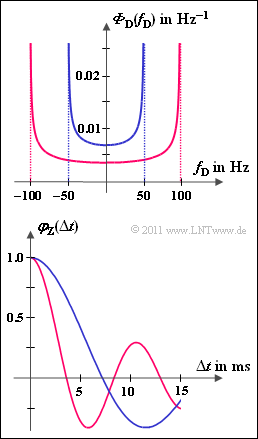Exercise 2.9: Coherence Time
In the frequency domain, the influence of Rayleigh fading is described by the Jakes spectrum . If the Rayleigh parameter is $\sigma = \sqrt{0.5}$ the Jakes spectrum is $${\it \Phi}_{\rm D}(f_{\rm D}) = \frac{1}{ \pi \cdot f_{\rm D,\hspace{0.05cm}max} \cdot \sqrt{1 - \left (\frac{f_{\rm D}}}{f_{\rm D,\hspace{0.05cm}max}}} \right )^2} } \hspace{0.05cm}.$$ for the Doppler frequency range $|f_{\rm D}| ≤ f_{\rm D, \ max}$: This function is sketched for $f_{\rm D, \ max} = 50 \ \rm Hz$ (blue curve) and $f_{\rm D, \ max} = 100 \ \rm Hz$ (red curve).
The function $\varphi_{\rm Z}(\delta t)$ is the inverse Fourier transform of the Doppler power density spectrum ${\it \Phi}_{\rm D}(f)$:
- $$\varphi_{\rm Z}(\Delta t ) = {\rm J}_0(2 \pi \cdot f_{\rm D,\hspace{0.05cm}max} \cdot \Delta t ) \hspace{0.05cm}.$$
${\rm J}_0$ denotes the zeroth-order Bessel function of the first kind. The correlation function $\varphi_{\rm Z}(\Delta t)$ which is also symmetrical, is drawn below, but for space reasons only the right half.
A characteristic value can be derived from each of these two description functions:
- The Doppler spread $B_{\rm D}$ refers to the Doppler PSD ${\it \Phi}_{\rm D}(f_{\rm D})$ and is equal to the standard deviation $\sigma_{\rm D}$ of the Doppler frequency $f_D$.
Note that the Jakes spectrum is zero-mean, so that the variance $\sigma_{\rm D}^2$ according to Steiner's theorem is equal to the second moment ${\rm E}\big[f_{\rm D}^2\big]$ . The calculation is analogous to the determination of the delay spread $T_{\rm V}$ from the delay PSD ${\it \Phi}_{\rm V}(\tau)$ ⇒ Exercise 2.7.
- The coherence time $T_{\rm D}$ on the other hand, refers to the time correlation function $\varphi_{\rm Z}(\Delta t)$ .
- $T_{\rm D}$ is the value of $\Delta t$– at which the magnitude $|\varphi_{\rm Z}(\Delta t)|$ first drops to half of the maximum $($at $\Delta t = 0)$ . One recognizes the analogy with the determination of the coherence bandwidth $B_{\rm K}$ from the frequency correlation function $\varphi_{\rm F}(\Delta f)$ ⇒ Exercise 2.7.
Notes:
- This task belongs to chapter GWSSUS–Kanalmodell.
- Reference is also made to chapter Allgemeine Beschreibung zeitvarianter Systeme.
- The following undefined integral is given:
- $$\int \frac{u^2}{\sqrt{1-u^2}} \hspace{0.15cm}{\rm d} u = -\frac{u}{2} \cdot \sqrt{1-u^2} + \frac{1}{2} \cdot {\rm arcsin}\,(u) \hspace{0.05cm}.$$
- Abschließend noch einige Werte für die Besselfunktion nullter Ordnung $({\rm J}_0)$:
- $${\rm J}_0(\pi/2) = 0.472\hspace{0.05cm},\hspace{0.4cm}{\rm J}_0(1.52) = 0.500\hspace{0.05cm},\hspace{0.4cm}{\rm J}_0(\pi) = -0.305\hspace{0.05cm},\hspace{0.4cm} {\rm J}_0(2\pi) = 0.221 \hspace{0.05cm}.$$
Questionnaire
Sample solution
- Doppler PDF and Doppler PSD are generally only identical in shape.
- But since in the example considered the integral over ${\it \Phi}_{\rm D}(f_{\rm D})$ is equal to $1$, recognizable by the correlation value $\varphi_{\rm Z}(\Delta t = 0) = 1$, even the identity is correct here.
- If the Rayleigh parameter $\sigma$ had been chosen differently, this would not apply.
(2) From the axial symmetry of ${\it \Phi}_{\rm D}(f_{\rm D})$ you can see that the mean value $m_{\rm D} = {\rm E}\big [f_{\rm D}\big] = 0$.
- The variance of the random variable $f_{\rm D}$ can thus be calculated directly as a square mean value:
$$\sigma_{\rm D}^2 = \int_{-\infty}^{+\infty} f_{\rm D}^2 \cdot {\it \Phi}_{\rm D}(f_{\rm D}) \hspace{0.15cm}{\rm d} f_{\rm D} = \int_{-f_{\rm D,\hspace{0.05cm}max}}}^{+f_{\rm D,\hspace{0.05cm}max}} \frac{f_{\rm D}^2}{ \pi \cdot f_{\rm D,\hspace{0.05cm}max} \cdot \sqrt{1 - \left ({f_{\rm D}}}/{f_{\rm D,\hspace{0.05cm}max}}} \right )^2} } \hspace{0.15cm}{\rm d} f_{\rm D} \hspace{0.05cm}.$$
- Using symmetry and with the substitution $u = f_{\rm D}/f_{\rm D, \ max}$ results in
$$\sigma_{\rm D}^2 = \frac{2}{\pi} \cdot f_{\rm D,\hspace{0.05cm}max}^2 \cdot \int_{0}^{1} \frac{u^2}{\sqrt{1-u^2} \hspace{0.15cm}{\rm d} u \hspace{0.05cm}. $$
- With the integral given on the data page you get further:
$$\sigma_{\rm D}^2 \hspace{-0.1cm} \ = \ \hspace{-0.1cm} \frac{2}{\pi} \cdot f_{\rm D,\hspace{0.05cm}max}^2 \cdot \left [ -\frac{u}{2} \cdot \sqrt{1-u^2} + \frac{1}{2} \cdot {\rm arcsin}\,(u) \right ]_0^1 = \frac{2}{\pi} \cdot f_{\rm D,\hspace{0.05cm}max}^2 \cdot \frac{2}{2}\cdot \frac{\pi}{2} = \frac{f_{\rm D,\hspace{0.05cm}max}^2}{2} \hspace{0.05cm}.$$
- The Doppler widening is equal to the scatter, i.e. the square root of the variance:
$$B_{\rm D} = \sigma_{\rm D} = \frac{f_{\rm D,\hspace{0.05cm}max}}}{\sqrt{2}}= \left\{ \begin{array}{c} \underline {35.35\,{\rm Hz}}\\\ \underline {70.7\,{\rm Hz}} \end{array} \right.\quad \begin{array}{*{*{1}c} {\rm f\ddot{u} \hspace{0.15cm}f_{\rm D,\hspace{0.05cm}max} = 50\,{\rm Hz} \\ {\rm f\ddot{u} \hspace{0.15cm}f_{\rm D,\hspace{0.05cm}max} = 100\,{\rm Hz} \\ \end{array} \hspace{0.05cm}. $$
(3) With the Bessel values given, one obtains
- for the Doppler frequency $f_{\rm D, \ max} = 50 \ \rm Hz$:
$$\varphi_{\rm Z}(\delta t = 5\,{\rm ms}) = {\rm J}_0(2 \pi \cdot 50\,{\rm Hz} \cdot 5\,{\rm ms} ) = {\rm J}_0(\pi/2) \hspace{0.1cm} \underline {= 0.472} \hspace{0.05cm},$$
- for the Doppler frequency $f_{\rm D, \ max} = 100 \ \rm Hz$:
$$\varphi_{\rm Z}(\delta t = 5\,{\rm ms}) = {\rm J}_0(\pi) \hspace{0.1cm} \underline {= -0.305} \hspace{0.05cm}.$$
(4) The correlation duration $T_{\rm D}$ is derived from the time correlation function $\varphi_{\rm Z}(\delta t)$. $T_{\rm D}$ is the $\delta t$–value where $|\varphi_{\rm Z}(\delta t)|$ has decayed to half of its maximum value. It must hold: $$\varphi_{\rm Z}(\delta t = T_{\rm D}) = {\rm J}_0(2 \pi \cdot f_{\rm D,\hspace{0.05cm}max} \cdot T_{\rm D}) \stackrel {!}{=} 0.5 \hspace{0.3cm} \Rightarrow \hspace{0.3cm} 2 \pi \cdot f_{\rm D,\hspace{0.05cm}max} \cdot T_{\rm D} = 1.52 \hspace{0.3cm} \Rightarrow \hspace{0.3cm} T_{\rm D} = \frac{1.52}{2 \pi f_{\rm D,\hspace{0.05cm}max}}} = \frac{0.242}{ f_{\rm D,\hspace{0.05cm}max}}$$ $$\Rightarrow \hspace{0.3cm} f_{\rm D,\hspace{0.05cm}max} = 50\,{\rm Hz}\text{:} \hspace{-0.1cm}\hspace{0.2cm}\hspace{0.2cm} T_{\rm D} \hspace{0.1cm} \underline {\approx 4.84\,{\rm ms} \hspace{0.05cm},\hspace{0.8cm} f_{\rm D,\hspace{0.05cm}max} = 100\,{\rm Hz}\text{:} \hspace{-0.1cm}\hspace{0.2cm}\hspace{0.2cm} T_{\rm D} \hspace{0.1cm} \underline {\approx 2.42\,{\rm ms} \hspace{0.05cm}. $$
(5) In the subtasks (2) and (4) we received
$$B_{\rm D} = \frac{ f_{\rm D,\hspace{0.05cm}max}}}}{\sqrt{2}}\hspace{0.05cm}, \hspace{0.2cm} T_{\rm D} = \frac{1.52}{2 \pi f_{\rm D,\hspace{0.05cm}max}}\hspace{0.3cm}
\Rightarrow \hspace{0.3cm} B_{\rm D} \cdot T_{\rm D} = \frac{1.52}{\sqrt{2} \cdot 2 \pi } \hspace{0.1cm}\underline {\approx 0.171}\hspace{0.05cm}.$$
Correct is therefore the last proposed solution.
